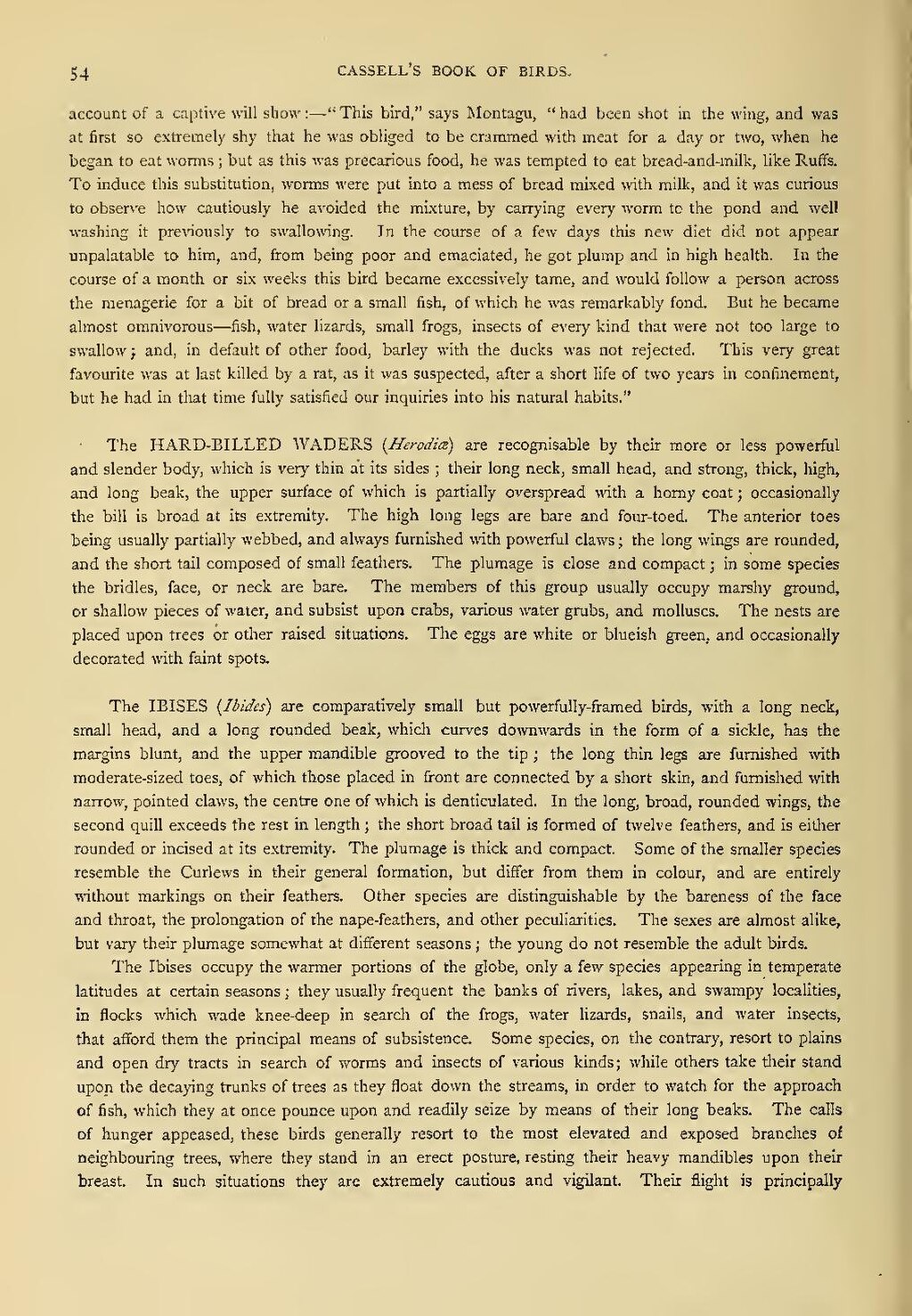account of a captive will show:—"This bird," says Montagu, "had been shot in the wing, and was at first so extremely shy that he was obliged to be crammed with meat for a day or two, when he began to eat worms; but as this was precarious food, he was tempted to eat bread-and-milk, like Ruffs. To induce this substitution, worms were put into a mess of bread mixed with milk, and it was curious to observe how cautiously he avoided the mixture, by carrying every worm to the pond and well washing it previously to swallowing. In the course of a few days this new diet did not appear unpalatable to him, and, from being poor and emaciated, he got plump and in high health. In the course of a month or six weeks this bird became excessively tame, and would follow a person across the menagerie for a bit of bread or a small fish, of which he was remarkably fond. But he became almost omnivorous—fish, water lizards, small frogs, insects of every kind that were not too large to swallow; and, in default of other food, barley with the ducks was not rejected. This very great favourite was at last killed by a rat, as it was suspected, after a short life of two years in confinement, but he had in that time fully satisfied our inquiries into his natural habits."
The HARD-BILLED WADERS (Herodiæ) are recognisable by their more or less powerful and slender body, which is very thin at its sides; their long neck, small head, and strong, thick, high, and long beak, the upper surface of which is partially overspread with a horny coat; occasionally the bill is broad at its extremity. The high long legs are bare and four-toed. The anterior toes being usually partially webbed, and always furnished with powerful claws; the long wings are rounded, and the short tail composed of small feathers. The plumage is close and compact; in some species the bridles, face, or neck are bare. The members of this group usually occupy marshy ground, or shallow pieces of water, and subsist upon crabs, various water grubs, and molluscs. The nests are placed upon trees or other raised situations. The eggs are white or blueish green, and occasionally decorated with faint spots.
The IBISES (Ibides) are comparatively small but powerfully-framed birds, with a long neck, small head, and a long rounded beak, which curves downwards in the form of a sickle, has the margins blunt, and the upper mandible grooved to the tip; the long thin legs are furnished with moderate-sized toes, of which those placed in front are connected by a short skin, and furnished with narrow, pointed claws, the centre one of which is denticulated. In the long, broad, rounded wings, the second quill exceeds the rest in length; the short broad tail is formed of twelve feathers, and is either rounded or incised at its extremity. The plumage is thick and compact. Some of the smaller species resemble the Curlews in their general formation, but differ from them in colour, and are entirely without markings on their feathers. Other species are distinguishable by the bareness of the face and throat, the prolongation of the nape-feathers, and other peculiarities. The sexes are almost alike, but vary their plumage somewhat at different seasons; the young do not resemble the adult birds.
The Ibises occupy the warmer portions of the globe, only a few species appearing in temperate latitudes at certain seasons; they usually frequent the banks of rivers, lakes, and swampy localities, in flocks which wade knee-deep in search of the frogs, water lizards, snails, and water insects, that afford them the principal means of subsistence. Some species, on the contrary, resort to plains and open dry tracts in search of worms and insects of various kinds; while others take their stand upon the decaying trunks of trees as they float down the streams, in order to watch for the approach of fish, which they at once pounce upon and readily seize by means of their long beaks. The calls of hunger appeased, these birds generally resort to the most elevated and exposed branches of neighbouring trees, where they stand in an erect posture, resting their heavy mandibles upon their breast. In such situations they are extremely cautious and vigilant. Their flight is principally
